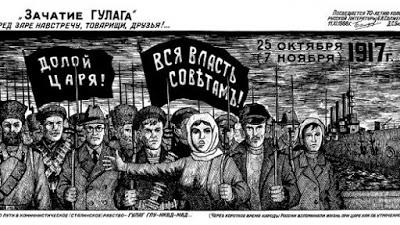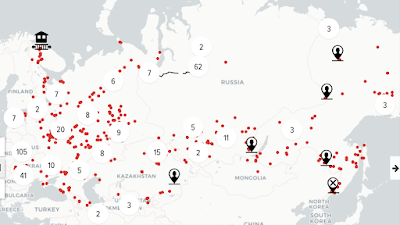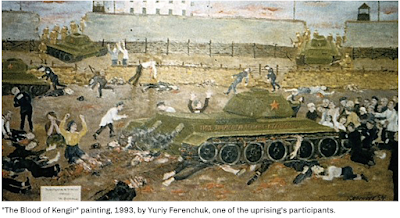
The ruthless authoritarianism and tyranny of Stalinist rule depended on a leader, a party, and a set of institutions that worked to terrorize and repress the population of the USSR. The NKVD (the system of internal security police that enforced Stalin's repression), a justice system that was embodied in the Moscow Show Trials of 1936-38, and especially the system of forced labor and prison camps that came to be known as the Gulag were the sharp end of the stick -- the machinery of repression through which a population of several hundred million people were controlled, imprisoned, and repressed. And, like the Nazi regime, Stalin used the slave labor of the camps to contribute to the economic output of the Soviet economy.
Anne Applebaum's Gulag: A History is a detailed and honest history of the Gulag and its role in maintaining Soviet dictatorship. Here is her summary description of the Gulag:
Literally, the word GULAG is an acronym, meaning Glavnoe Upravlenie Lagerei, or Main Camp Administration. Over time, the word “Gulag” has also come to signify not only the administration of the concentration camps but also the system of Soviet slave labor itself, in all its forms and varieties: labor camps, punishment camps, criminal and political camps, women’s camps, children’s camps, transit camps. Even more broadly, “Gulag” has come to mean the Soviet repressive system itself, the set of procedures that prisoners once called the “meat-grinder”: the arrests, the interrogations, the transport in unheated cattle cars, the forced labor, the destruction of families, the years spent in exile, the early and unnecessary deaths. (13)Here is a map of the locations of thousands of camps in the Gulag, according to the Gulag.online museum (link). (This site is worth visiting and exploring.) It is remarkable how many of the camps are in the borderlands or bloodlands of eastern Europe, Ukraine, and Baltic states as defined by Prusin and Snyder.

Applebaum estimates that roughly two million prisoners inhabited the camps at a time in the 1940s, and that as many as 18 million people had passed through the camps by 1953 (13). And the economic role of the Gulag was considerable:
By that time the camps had come to play a central role in the Soviet economy. They produced a third of the country’s gold, much of its coal and timber, and a great deal of almost everything else. In the course of the Soviet Union’s existence, at least 476 distinct camp complexes came into being, consisting of thousands of individual camps, each of which contained anywhere from a few hundred to many thousands of people. The prisoners worked in almost every industry imaginable—logging, mining, construction, factory work, farming, the designing of airplanes and artillery—and lived, in effect, in a country within a country, almost a separate civilization. (13)Applebaum makes a crucial and important point about historical knowledge as she frames her attempt to put together the history of the Gulag: the inherent incompleteness of historical understanding and the mechanisms of overlooking and forgetting that get in the way of historical honesty. She notes that public knowledge of the camps outside the Soviet Union was available, but was de-dramatized and treated as a fairly minor part of the reality of the USSR.
Yet although they lasted as long as the Soviet Union itself, and although many millions of people passed through them, the true history of the Soviet Union’s concentration camps was, until recently, not at all well known. By some measures, it is still not known. Even the bare facts recited above, although by now familiar to most Western scholars of Soviet history, have not filtered into Western popular consciousness. “Human knowledge,” once wrote Pierre Rigoulot, the French historian of communism, “doesn’t accumulate like the bricks of a wall, which grows regularly, according to the work of the mason. Its development, but also its stagnation or retreat, depends on the social, cultural and political framework.” (16)The reality -- that the USSR embodied and depended upon a massive set of concentrations camps where millions of people were enslaved and killed -- was never a major part of the Western conception of the USSR. She comments, "far more common, however, is a reaction of boredom or indifference to Stalinist terror" (18), and she quotes the odious Jean-Paul Sartre, apologist for Stalinism to the end:
“As we were not members of the Party,” he once wrote, “it was not our duty to write about Soviet labor camps; we were free to remain aloof from the quarrels over the nature of the system, provided no events of sociological significance occurred.” On another occasion, he told Albert Camus that “Like you, I find these camps intolerable, but I find equally intolerable the use made of them every day in the bourgeois press.” (18)It is interesting though not surprising to know that there were a number of major rebellions in large camps in the Gulag, which Applebaum describes in a chapter called "The Zeks' Revolution". The largest of these was the Kengir uprising in Kazakhstan. This rebellion occurred in spring 1954 (after the death of Stalin) and was put down some 40 days later by overwhelming military force, including tanks. Solzhenitsyn provided an extensive description of this uprising in the third volume of Gulag Archipelago in a chapter titled "The forty days of Kengir" (link). (Here is an analysis of the Kengir uprising by Steven Barnes in Slavic Review; link.)
Wide knowledge in the West of the scope and specific human catastrophe of the Gulag was first made available by Aleksandr Isayevich Solzhenitsyn in The Gulag Archipelago, first published in Russian and English in 1973. And he wrote, not as an investigative journalist, but as a former prisoner, a zek. While serving in the Red Army in 1945 Aleksandr Isayevich was convicted of anti-Soviet propaganda under Article 58 and sentenced to eight years of forced labor. He spent the full eight years in several different camps in the Gulag, from 1945 to 1956. Following his release he lived in internal exile in Kazakhstan for several years before being pardoned by Nikita Khrushchev.
Here are the opening lines of The Gulag Archipelago:
How do people get to this clandestine Archipelago? Hour by hour planes fly there, ships steer their course there, and trains thunder off to it-but all with nary a mark on them to tell of their destination. And at ticket windows or at travel bureaus for Soviet or foreign tourists the employees would be astounded if you were to ask for a ticket to go there. They know nothing and they've never heard of the Archipelago as a whole or of anyone of its innumerable islands.
Those who go to the Archipelago to administer it get there via the training schools of the Ministry of Internal Affairs. Those who go there to be guards are conscripted via the military conscription centers.
And those who, like you and me, dear reader, go there to die, must get there solely and compulsorily via arrest.
Arrest! Need it be said that it is a breaking point in your life, a bolt of lightning which has scored a direct hit on you? That it is an unassimilable spiritual earthquake not every person can cope with, as a result of which people often slip into insanity?
The Universe has as many different centers as there are living beings in it. Each of us is a center of the Universe, and that Universe is shattered when they hiss at you: "You are under arrest."
If you are arrested, can anything else remain unshattered by this cataclysm?
In 1978 -- thirty-three years after his own arrest at the German front while serving as a decorated combat officer in the Red Army -- Solzhenitsyn gave the commencement address at Harvard University, and he offered these important words about hard truths:
Harvard's motto is "VERITAS." Many of you have already found out and others will find out in the course of their lives that truth eludes us as soon as our concentration begins to flag, all the while leaving the illusion that we are continuing to pursue it. This is the source of much discord. Also, truth seldom is sweet; it is almost invariably bitter. A measure of truth is included in my speech today, but I offer it as a friend, not as an adversary.
...
A decline in courage may be the most striking feature that an outside observer notices in the West today. The Western world has lost its civic courage, both as a whole and separately, in each country, in each government, in each political party, and, of course, in the United Nations. Such a decline in courage is particularly noticeable among the ruling and intellectual elites, causing an impression of a loss of courage by the entire society. There are many courageous individuals, but they have no determining influence on public life.
Political and intellectual functionaries exhibit this depression, passivity, and perplexity in their actions and in their statements, and even more so in their self-serving rationales as to how realistic, reasonable, and intellectually and even morally justified it is to base state policies on weakness and cowardice. And the decline in courage, at times attaining what could be termed a lack of manhood, is ironically emphasized by occasional outbursts and inflexibility on the part of those same functionaries when dealing with weak governments and with countries that lack support, or with doomed currents which clearly cannot offer resistance. But they get tongue-tied and paralyzed when they deal with powerful governments and threatening forces, with aggressors and international terrorists.The primary truths that Solzhenitsyn addressed that afternoon in Cambridge concerned the realities of colonialism and the Cold War and the moral failures of Western intellectuals and political leaders to confront authoritarianism and injustice. These are important words for us in the United States today; both truth and courage are called for. But beyond the present, these ideas underline the importance of the honest historical writings of scholars like Snyder, Judt, Applebaum, Gross, and Prusin in describing the catastrophes of the twentieth century. Solzhenitsyn himself demonstrated that courage and that commitment to revealing the truth about a gigantic and secret system of repression.
 source: Russia Beyond
source: Russia Beyond